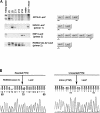Proximity-dependent and proximity-independent trans-splicing in mammalian cells
- PMID: 18441053
- PMCID: PMC2390811
- DOI: 10.1261/rna.384808
Proximity-dependent and proximity-independent trans-splicing in mammalian cells
Abstract
Most human pre-mRNAs are cis-spliced, removing introns and joining flanking exons of the same RNA molecule. However, splicing of exons present on separate pre-mRNA molecules can also occur. This trans-splicing reaction can be exploited by pre-trans-splicing molecules (PTMs), which are incapable of cis-splicing. PTM-mediated trans-splicing has been utilized to repair mutant RNAs as a novel approach to gene therapy. Herein we explore how the site of PTM expression influences trans-splicing activity. We stably inserted a PTM expression cassette into the genome of HEK293 cells, generating clonal lines with single, unique insertion sites. We analyzed trans-splicing to the gene where the PTM was integrated, as well as genes neighboring these loci. We observed some pre-mRNAs only serve as substrates for trans-splicing when they are expressed in immediate proximity to the PTM expression site. The need for PTMs to be in close proximity with pre-mRNAs to trans-splice with them is consistent with the observation that pre-mRNA cis-splicing occurs cotranscriptionally. Interestingly, we identified several cellular pre-mRNAs in one localized area that serve as trans-splicing substrates irrespective of the PTM expression site. Thus, we find multiple cellular pre-mRNAs require PTM expression in close proximity to trans-splice while others do not.
Figures





Similar articles
-
Repair of CFTR mRNA by spliceosome-mediated RNA trans-splicing.Gene Ther. 2000 Nov;7(22):1885-95. doi: 10.1038/sj.gt.3301307. Gene Ther. 2000. PMID: 11127576
-
Dysferlin rescue by spliceosome-mediated pre-mRNA trans-splicing targeting introns harbouring weakly defined 3' splice sites.Hum Mol Genet. 2015 Jul 15;24(14):4049-60. doi: 10.1093/hmg/ddv141. Epub 2015 Apr 22. Hum Mol Genet. 2015. PMID: 25904108
-
5' exon replacement and repair by spliceosome-mediated RNA trans-splicing.RNA. 2003 Oct;9(10):1290-7. doi: 10.1261/rna.5101903. RNA. 2003. PMID: 13130143 Free PMC article.
-
Trans-splicing.Wiley Interdiscip Rev RNA. 2011 May-Jun;2(3):417-34. doi: 10.1002/wrna.71. Epub 2011 Jan 20. Wiley Interdiscip Rev RNA. 2011. PMID: 21957027 Review.
-
Pre-mRNA structures forming circular RNAs.Biochim Biophys Acta Gene Regul Mech. 2019 Nov-Dec;1862(11-12):194410. doi: 10.1016/j.bbagrm.2019.194410. Epub 2019 Aug 14. Biochim Biophys Acta Gene Regul Mech. 2019. PMID: 31421281 Review.
Cited by
-
The evolutionary landscape of intergenic trans-splicing events in insects.Nat Commun. 2015 Nov 2;6:8734. doi: 10.1038/ncomms9734. Nat Commun. 2015. PMID: 26521696 Free PMC article.
-
Detection of novel paraja ring finger 2-fer tyrosine kinase mRNA chimeras is associated with poor postoperative prognosis in non-small cell lung cancer.Cancer Sci. 2013 Nov;104(11):1447-54. doi: 10.1111/cas.12250. Epub 2013 Sep 5. Cancer Sci. 2013. PMID: 23931849 Free PMC article.
-
Introns and Their Therapeutic Applications in Biomedical Researches.Iran J Biotechnol. 2023 Oct 1;21(4):e3316. doi: 10.30498/ijb.2023.334488.3316. eCollection 2023 Oct. Iran J Biotechnol. 2023. PMID: 38269198 Free PMC article. Review.
References
-
- Akopian A.N., Okuse K., Souslova V., England S., Ogata N., Wood J.N. Trans-splicing of a voltage-gated sodium channel is regulated by nerve growth factor. FEBS Lett. 1999;445:177–182. - PubMed
-
- Bickmore W.A., Sumner A.T. Mammalian chromosome banding—An expression of genome organization. Trends Genet. 1989;5:144–148. - PubMed
-
- Caudevilla C., Da Silva-Azevedo L., Berg B., Guhl E., Graessmann M., Graessmann A. Heterologous HIV-nef mRNA trans-splicing: A new principle how mammalian cells generate hybrid mRNA and protein molecules. FEBS Lett. 2001b;507:269–279. - PubMed
Publication types
MeSH terms
Substances
LinkOut - more resources
Full Text Sources
Miscellaneous
